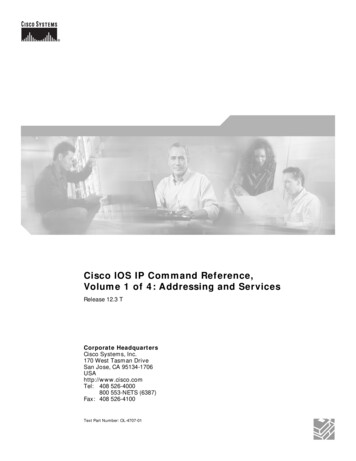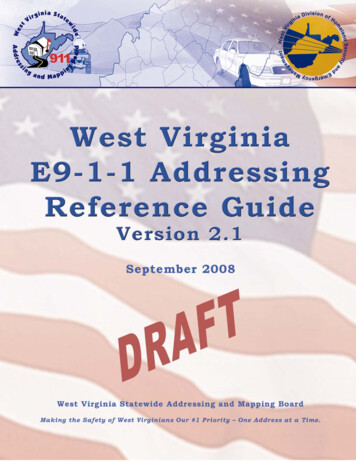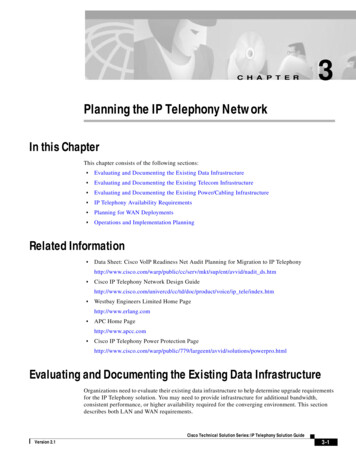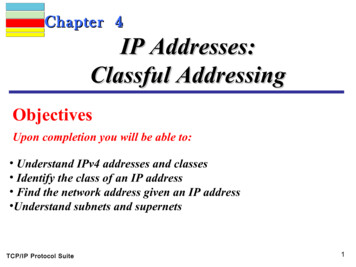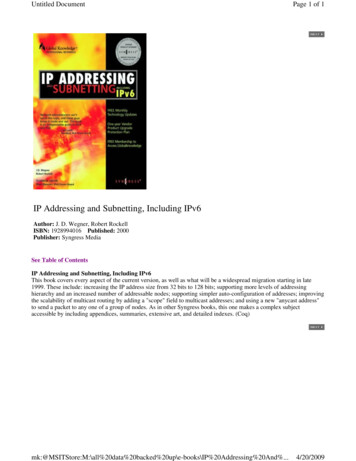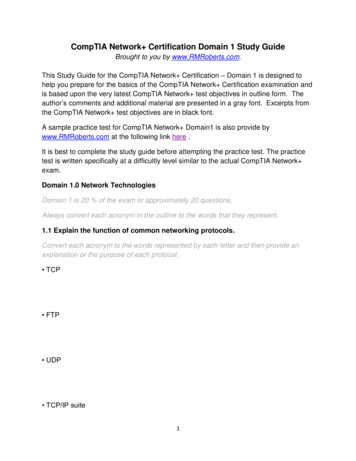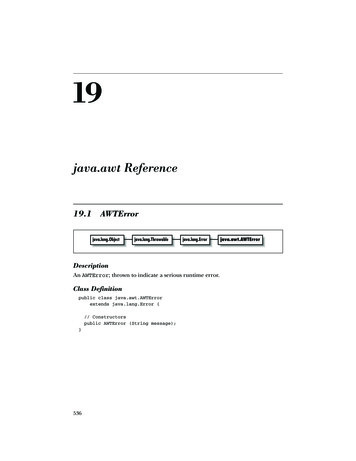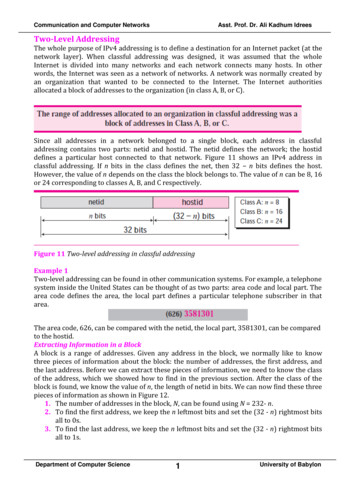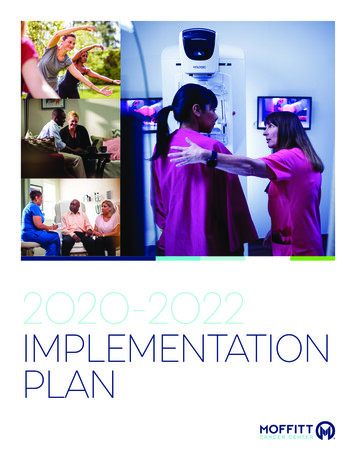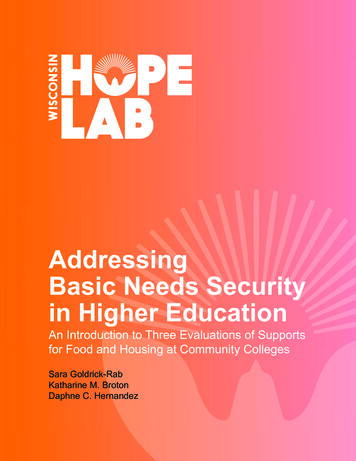
Transcription
AddressingBasic Needs Securityin Higher EducationAn Introduction to Three Evaluations of Supportsfor Food and Housing at Community CollegesSara Goldrick-RabKatharine M. BrotonDaphne C. Hernandez
There is a new economics of college in America. At a time when more people than ever before areturning to college in search of a decent life marked by economic stability, college completion ratesin the United States are stagnant. This is especially true at the public colleges and universitieswhere most students enroll. Even community colleges, long positioned as the most accessibleand affordable points of entry to higher education, are increasingly out of reach. The federal PellGrant, which once covered the full cost of attending community college, now covers about 60%.The remaining balance is high, especially compared with the discretionary income of today’scommunity college students.1Increased enrollment of lower and moderate income students coupled with inadequate employmentopportunities and high college prices mean that making ends meet while attending collegecan be very difficult. In fact, a growing body of evidence suggests that a previously unnoticedchallenge has emerged: basic needs insecurity.2 According to a recent report by the WisconsinHOPE Lab, over half (56%) of students at 70 community colleges across the nation are foodinsecure, experiencing reductions in the quality or quantity of their diet. Even more students reportthat they are worried about their food supply. Similarly, half of community college students areinsecure in their living arrangements as indicated by housing unaffordability and instability (35%),or outright homelessness (14%). On March 20, 2017 the United States Government AccountabilityOffice announced that it would undertake the first-ever federal review of food insecurity in highereducation, a clear indication that this challenge deserves greater attention.3Insufficient access to adequate food and safe, secure housing inhibits academic success at alllevels of education. Indeed, a sizable body of research demonstrates that better nourished k-12students perform better in school and that school meal programs can improve academic success.4But Bunker Hill Community College President Pam Eddinger points out that in a vacuum of relateddata and research food and housing insecurity had been overlooked in efforts to promote retentionand completion in higher education. “We [have] doubled down on developmental math and EnglishGoldrick-Rab, S. (2016). Paying the Price: College Costs, Financial Aid, and the Betrayal of the American Dream.University of Chicago Press; The Institute for College Access and Success. (2017). A State-By-State Look atCollege (Un)Affordability. April.2For an exhaustive list of the relevant studies, see Wisconsin HOPE Lab. (2017). Annotated Bibliography: BasicNeeds Insecurity Among College Students. http://wihopelab.com3Sloane, W. (2017). “Food Is a Basic Need: Dealing With Hunger on College Campuses.” Higher Ed Today. May 31.4Anderson, M.L., Gallagher, J. & Ritchie, E.R.R. (2017). School lunch quality and academic performance. NBERWorking Paper 23219, March; Figlio, D.N. & Winicki, J. (2005), Food for thought: The effects of school accountabilityplans on school nutrition. Journal of Public Economics, 89:381–394, 2005; Frisvold, D.E. (2015); Nutrition andcognitive achievement: An evaluation of the school breakfast program. Journal of Public Economics, 124:91–104;Imberman, S.A. & Kugler, A.D. (2014), The effect of providing breakfast on student performance. Journal of PolicyAnalysis and Management, 33:669–699.1WISCONSIN HOPE LAB Addressing Basic Needs Security in Higher Education2
reform. We built guided pathways and early colleges. We advised and coached. We insisted ona culture of evidence. We created cohorts and learning communities. We called for the educationof the whole student. But, in a fundamental way, we failed to address what a student needs to beeducated,” she said.5In the past five years, research reports, a wave of media coverage, and organizing and advocacyby students, practitioners, and legislators throughout the country have helped to change theconversation.6 Now that the challenge is more visible, colleges are seeking effective approachesto both proactively secure students’ basic needs and reactively address current problems. Thissummer California Governor Jerry Brown signed a budget providing 7.5 million for “hungerfree” college campuses throughout that state, and the Los Angeles County Board of Supervisorsdesignated homeless college students as beneficiaries of a sales tax increase passed earlier thisyear.7 However the success of those investments and the adoption of similar initiatives aroundthe country require the development of a body of evidence on effective practices that can beimplemented and sustained by colleges and their community partners.Testing Community-Driven ApproachesCan providing food and housing assistance improve the educational and social outcomes ofcommunity college students in need? Efforts to address food and housing are developing incommunities around the country. The College and University Food Bank Alliance now has morethan 500 members at colleges and universities from coast to coast. Swipe Out Hunger boasts 26chapters, mainly on the East and West coasts. Single Stop is helping community college studentsaccess food stamps and the Earned Income Tax Credit, and home-grown programs at institutionsin many states are integrating benefits access into their financial aid and student affairs portfolios.Jovenes, Inc. links homeless youth in Los Angeles to supportive housing, while the SouthernScholarship Foundation in Florida provides rent-free housing to college students with financialneed.Eddinger, P. (2017). “Food for Thought.” Bunker Hill Community College Magazine. Spring. P.9.http://www.bhcc.edu/magazine/BHCCMag June2017 6.30.pdf6Media coverage has appeared in the pages of the New York Times, Washington Post, Chronicle of HigherEducation, and on television programs including Daily Show with Trevor Noah. In addition to reports from theWisconsin HOPE Lab, the Urban Institute has joined researchers at institutions including the City University of NewYork, University of the Pacific, University of California-Berkeley, Cal State University-Long Beach, and HumboldtState University—among many others—in studying this challenge.7Holland, G. (2017), “1 in 5 L.A. Community College Students is Homeless, Survey Finds.” Los Angeles Times,June 29; Swipe Out Hunger (2017), Gov Brown Signs CA State Budget- Approves 7.5 Million for ‘Hunger-FreeCollege Campuses.’” SIN HOPE LAB Addressing Basic Needs Security in Higher Education3
Several studies have examined the prevalence of food and housing insecurity in higher education,and some have considered the association between basic needs insecurity and academicoutcomes, yet there have been very few studies rigorously testing the impact of these sorts ofinterventions designed to ameliorate any negative effects on college students.8 Factors that areassociated with student participation in food and housing programs, including lower-incomes butalso help-seeking behaviors, are also associated with the odds of academic success. This makesit hard to isolate the impacts of such programs. While many of the programs just mentioned aredeveloping evaluations, only Single Stop has been assessed.9Launching three new experimental evaluations of promising approaches to addressing food andhousing insecurity is therefore a bold step forward in moving work on basic needs insecurity fromthe “problem” space to the “solution” space. Over the next three years, our team at the WisconsinHOPE Lab (and the forthcoming HOPE Center for College, Community, and Justice in Philadelphia)will work with community college leaders in Boston, Houston, and Tacoma to test, refine, and scaleefforts to improve students’ wellbeing and in turn boost their odds of degree completion. All threeprograms were developed by community colleges and their partners based on their local needs,resources, and opportunities. The evaluations are made by possible because of generous financialsupport from The Kresge Foundation.Meal Vouchers at Bunker Hill Community College (Boston)Bunker Hill Community College (BHCC) is a multi-campus, urban institution serving over 13,000students in the Greater Boston area. It is the largest and one of the most diverse communitycolleges in Massachusetts. Approximately 60 percent of BHCC students are people of color andmore than 50 percent are women. There are nearly 1,000 international students who come from105 countries and speak more than 75 languages. The average age of BHCC students is 26 andmost work while attending college. The college has been recognized by the Achieving the Dreaminitiative, the Bill & Melinda Gates Foundation, and others for its commitment to improving studentsuccess and equity.BHCC leaders have long been aware that their students endure food insecurity. They have had aSingle Stop office for several years, and sought private donations to establish several initiatives—most recently, the One Solid Meal (OSM) Pilot Program. The OSM program is supported by theBunker Hill Community College Foundation donors, and administered by the College’s HungerSee Wisconsin HOPE Lab (2017) for a review of studies on prevalence. A quasi-experimental evaluation ofimpacts of food and housing insecurity on college performance can be found in Broton, K. (2017). The Evolutionof Poverty in Higher Education: Material Hardship, Academic Success, and Policy Perspectives. University ofWisconsin-Madison Dissertation.9Daughterty, L., Johnston, W., & Tsai, T. (2016). Connecting College Students to Alternative Sources of Support.RAND Corporation.8WISCONSIN HOPE LAB Addressing Basic Needs Security in Higher Education4
Team. The Team is a cross-functional group that includes the Single Stop director; a transfercounselor; executive directors from Institutional Research, Communications and the CollegeFoundation; and the Dean of Students. In the pilot program, students who self-identified as foodinsecure received vouchers that enabled them to eat for free in the College’s food service venuesduring the spring 2016 semester.All participating students completed the semester and the pilot program was extended for the fall2016 and spring 2017 semesters. Of the 30 participants, 29 students completed all three semestersand eight students graduated. The Core Team also considered the students’ experiences withthe program by conducting focus groups, and worked with their cafeteria to improve the fooddistribution process.Building on that success and lessons learned during thepilot project, BHCC worked with the Wisconsin HOPE Labto expand and refine the OSM initiative. In fall 2016, theHOPE Lab conducted a survey and the results suggestedthat 56 percent of BHCC students were food insecure. Inresponse, BHCC grew the size of the initiative and adjustedthe program’s outreach so as to bring services to students,rather than waiting for them to come forward. This new effortis now targeted to students during their first year in order tohelp students get the best possible start in college.“Never in a million yearswould I have predictedwhen I started communitycollege work 25 yearsago that hunger andhomelessness wouldbe barriers to a collegeeducation”—Pam Eddinger,President, Bunker HillCommunity CollegeTo identify students for the program in fall 2017, an emailwas sent to all students enrolling at the College for the firsttime, inviting them to take a survey that included the U.S.Department of Agriculture’s standardized food insecurityassessment. In addition, students in the College’s LearningCommunity courses for first-year students were encouraged in class and by their peer mentorsto take the survey. Students who were identified as food insecure became eligible for support.Participating students receive a 25 voucher each week and funds are placed onto a debit card thatallows students to buy food that is offered in the BHCC food service venues. Over the academicyear, this translates into 750 in additional food support. Participating students have regular contactwith BHCC Single Stop staff, who reach out by email, phone or text message. Students are askedto stop into the BHCC Single Stop office at least once per semester so that they can connect withpersonnel who are able to assess students’ needs and connect them to services and resources.WISCONSIN HOPE LAB Addressing Basic Needs Security in Higher Education5
Meal vouchers are costly, however, and even with generous support from the Boston Foundation,Kresge, and private donors, BHCC is unable offer this program to all students who need it.Therefore, among eligible students, 110 students were selected at random to participate in theprogram during the 2017-18 academic year. All students, including those not in the program,are eligible to participate in a wide range of academic and student support services including amobile market, food pantry, discounts for public transportation, aid with waiving health insurancerequirements, help with completing FAFSA, financial literacy workshops, and reminders regardingresume writing, transferring, job opportunities, and scholarships.The evaluation team, led by Drs. Katharine M. Broton and Sara Goldrick-Rab, is tracking andanalyzing the outcomes of program participants as well as eligible students who were not selectedto participate. They are assessing students’ educational performance including course completionrates, GPA, persistence and credential attainment, and surveying students to learn about their wellbeing, including levels of food security and stress. An implementation study is being conducted tounderstand how students perceive and utilize the program and other support services, as well asany unintended program challenges or consequences.The study will provide an estimate of the causal impact of an on-campus food assistance programon community college students’ academic success and well-being. The results should be of greatinterest to colleges around the country, most of whom provide food services on campus and couldimplement such a program with their providers. They will also speak to the likely impact of “swipe”programs, and further shed some light on the potential impacts of expanding a free or subsidizedmeal program—like the one implemented in America’s k-12 schools—to community colleges.Food Scholarships at Houston Community CollegeHouston Community College (HCC) is one of the largest community colleges in the country,educating over 100,000 students each year, with a student-to-faculty ratio of 24-to-1. More thanhalf (58%) of HCC’s students qualify for the federal Pell Grant. HCC is designated as a HispanicServing Institution (37% of the student body is Hispanic) and an Other-Minority Serving Institution(greater than 50% overall minority, with nearly 30% being black or African American).But like many community colleges, HCC has prioritized academic supports and traditional financialaid without making room for other sorts of financial supports. “We have long focused our effortson student services initiatives designed to enhance student outcomes However, we have lots ofwork to move from knowing that a hungry student can’t be an effective learner to finding a solutionto address a basic need affecting the achievement gap,” notes Muddassir Siddiqi, President,Houston Community College-Central Campus. That is now changing with the implementation ofan innovative new program at HCC, a partnership between the college and its local food bank, todistribute “food scholarships” to students.WISCONSIN HOPE LAB Addressing Basic Needs Security in Higher Education6
The Houston Food Bank (HFB) is the largest food bank inthe United States in terms of meals distributed, and in 2015it was named “Food Bank of the Year” by Feeding America,the largest hunger-relief charity in the nation. HFB developedthe Food Scholarship Program as part of its Food-for-ChangeProgram, which provides food to individuals who participatein social service programs that can potentially lift them outof poverty or improve their lives. Ultimately, Food-for-Changeseeks to reduce the number of families who need foodassistance and help them achieve self-sufficiency.In fall 2017, a new partnership between HFB and HCC began inorder to support students at that college. This strategic externalpartnership helps HFB achieve its mission of feeding Houston,while helping HCC accomplish its goal of being responsive tostudents’ needs.“I’ve witnessed the scoresof students who becomediscouraged due to theireconomic challenges.The Food ScholarshipProgram addresses oneof the key economicchallenges students face– food insecurity. I amglad to be a part of anorganization that exploresinnovative collaborationsto support our students’dreams.”—Joel Philistin, HoustonCommunity College FoodScholarship Project LeadFood scholarships simply provide food to students. The supportis available from HFB as long as students remain enrolled atHCC. Students get groceries from HFB twice per month atdesignated food pantry locations around the city, which arewithin a ten-mile radius of each campus. Access to groceriesthrough the food pantries is available daily, including eveningsand weekends. Once every two weeks, in parking lots adjacent to HCC campuses, a mobile foodpantry delivers food and distributes it in a manner similar to farmer’s markets.Food scholarship recipients have choices about the food they select in the program, reducing wasteand increasing the value of the scholarship. Many HCC students live in food deserts throughoutthe city, limiting their access to healthy food. But food scholarships offer access to fresh fruits andvegetables, frozen meat, milk, bread, grains, cereals, canned protein and peanut butter, eggs, andcanned produce. Participants also have access to cooking tips that correspond to available produce.During the initial year of implementation, food scholarships are being offered at HCC’s Centraland Northeast campuses. The program is housed in the financial aid office and supported byits financial coaches. The support is provided proactively to new and continuing students whocomplete the FAFSA and have no Expected Family Contribution and an income of 25,000 orless. HFB is supporting 350 scholarships for the 2017-2018 academic year and HCC selects therecipients at random from among all eligible students.WISCONSIN HOPE LAB Addressing Basic Needs Security in Higher Education7
The food scholarship, including the amount and types of food that students select, and the impactson their food security are being assessed by Drs. Daphne Hernandez and Sara Goldrick-Rab.They are tracking the educational outcomes of all students selected for the program along witha comparison group of students not selected, and comparing the results in order to estimate theprogram’s casual impact. An implementation study is also taking place.There are approximately 200 food banks operating in the United States, and many are located inor near the cities and towns where community colleges also reside. Strategic external partnershipslike the one between the Houston Food Bank and Houston Community College offer benefits toboth partners while producing support for students and their families that may have lasting impact.While campus food pantries are often utilized by students only after they face a shortfall, foodscholarships are a proactive approach to helping students reduce their grocery expenses whilesecuring the food that they need.Housing Vouchers at Tacoma Community CollegeTacoma Community College (TCC) is a moderate-sized community college located in the city ofTacoma, about 35 miles outside Seattle, that enrolls just under 7,000 students a year. Two-thirds ofthose students are women (often with children), about half are people of color, 45 percent are overthe age of 25, and one- third receive the federal Pell Grant.Housing insecurity is a serious problem at TCC. A 2016 survey by the Wisconsin HOPE Lab foundthat at TCC almost 70 percent of students were housing insecure and 26 percent were homeless.Approximately 17 percent had been evicted or thrown out of their homes, and 16 percent slept in ashelter, abandoned building, or car.Housing stability has demonstrable impacts on students’ school performance and yet housinginterventions have not consistently produced positive impacts on educational outcomes. As a result,housing authorities around the nation are testing new programs, including those that expand thecontinuum of support into higher education. For many decades, the U.S. Department of Housingand Urban Development (HUD) has operated the Jobs Plus and Family Self-Sufficiency program,connecting people receiving housing assistance with opportunities to attain higher education andskills. The College Housing Assistance Program (CHAP) created by the Tacoma Housing Authority(THA) and TCC complements that strategy by instead targeting housing assistance to people whohave already enrolled in higher education but have severe housing needs.CHAP is part of the THA’s broader Education Project which has two main purposes: it seeks to helpthe people it houses succeed in school/college and it seeks to promote the success of schools andcolleges serving low-income students. CHAP is financed by HUD’s Moving to Work program. Theprogram offers housing vouchers to current TCC students who are homeless or near homeless. Itbegan in September 2014 when it offered housing vouchers to 25 homeless TCC students and theirWISCONSIN HOPE LAB Addressing Basic Needs Security in Higher Education8
dependents. It has continued to serve about 25 students peryear since that time.CHAP has received a great deal of attention, includinga feature in HUD’s Guidebook to Addressing HousingInsecurity and Living Costs in Higher Education.10 There isgood reason: it is an innovative program and initial evidencesuggests that the program’s effects on educational outcomesmay be on the larger side. For example, the program reportsthat 95 percent of participating community college students(21 out of 22) remained enrolled a year later compared with24 percent of eligible applicants (35 out of 146) who werenot served.11In September 2017 CHAP expanded to provide 150 housingvouchers to TCC students who are homeless or nearhomeless, as well as some TCC students who began theirstudies while in prison. Most of these students are womenwith children. The program requires that students must makeadequate academic progress toward a degree, includingenrolling full-time, but it also offers support and counselingto help them meet those demands. The housing assistancelasts until graduation or three years, whichever occursfirst. Recycled vouchers are distributed to new programparticipants.“The housing dollar is themain cost of this program,and it is scalable for us(within the limits of ourresources) because wedo not count that dollaras a project expense. Wewould be spending thatdollar anyway housingsomeone. The challengeis to find ways to spendthat dollar not just tohouse someone in needbut also to help them andtheir children succeed inschool. When it works itis a very good use of ahousing dollar.”—Michael Mirra,Executive Director,Tacoma HousingAuthorityThe Dean of Counseling and Advising at TCC leads theoutreach effort to advise students about the program.Information is distributed throughout many offices on campus and in the community, and sentdirectly to students who identify as homeless on their financial aid application or on surveys usedto assess students’ housing insecurity. The Dean’s office screens program applicants and thenplaces eligible students into one of two groups:Sackett, C., Goldrick-Rab, S., & Broton, K. (2016). Addressing Housing Insecurity and Living Costs in HigherEducation: A Guidebook for Colleges and Universities. Washington, DC: U.S. Department of Housing and UrbanDevelopment.11Tacoma Housing Authority. (2015). Tacoma Community College Housing Assistance Program: A Summary.September 11. rint gram%20Description%202015-9-12.pdf10WISCONSIN HOPE LAB Addressing Basic Needs Security in Higher Education9
Homeless students. Must be in an emergency shelter or in a transitional housing facility or be aclient of a case-management program serving the homeless.Near-homeless students. Must meet at least one of the following criteria: (1) Unable to meet basichousing expenses such as rent, mortgage, or utilities that will result in the loss of permanenthousing; (2) Residing in a motel/hotel due to loss of permanent housing and lacks the resources toremain; (3) Has lost permanent housing and is living temporarily with a friend or family member andcannot be placed on the lease; (4) Eviction notices that will result in loss of permanent housing; (5)Pending unlawful detainer notices that will result in loss of permanent housing; (6) Recent historyof serious housing instability; (7) Is a victim of domestic violence; (8) Is facing discharge from apublic institution (e.g. incarceration, hospital etc.) without a housing discharge plan.Homeless students are immediately referred to THA for vouchers. Near-homeless students areplaced into a lottery conducted three times a year (Fall, Winter, and Spring) and approximately halfof the eligible students in that group are awarded vouchers, depending on availability.The evaluators—Drs. Sara Goldrick-Rab and Katharine M. Broton, along with Dr. Sarah Cordesof Temple University and researchers at Education Northwest— are constructing a databasethat includes education and financial aid data from TCC and housing data from THA along withsocial, health, and criminal justice data for individuals served by Washington State’s Departmentof Social and Health (DSHS). This uncommonly rich data set will allow them to assess of a rangeof outcomes including:Short-term: improvements in educational performance, including course completion rates, GPAand retention, measured with TCC data; effective use of financial aid, including FAFSA applicationand strategic use of loans, measured with TCC data; reductions in food insecurity and financialstress, measured with surveys; improvements in housing quality and stability, including receipt ofemergency shelter, transitional housing, rent assistance, and permanent/permanent supportivehousing recorded in the Homeless Management Information System and supplemented by THArecords; reductions in risky behaviors as measured by health and behavioral health system data,including health status based on chronic illness risk scores, alcohol or other drug treatment need,injuries, and mental illness, and criminal justice data, including interaction with courts, jails, orprisons, measured with DSHS data.Longer-term: completion of credentials; improvements in employment and earnings, measuredwith DSHS data; reductions in the use of public benefits, measured by public assistance data onhousing status recorded by DSHS financial eligibility caseworkers as well as receipt of servicesthrough the DSHS Economic Services Administration.WISCONSIN HOPE LAB Addressing Basic Needs Security in Higher Education10
In addition to the analysis of program impacts leveraging the experimental design to look at effectsfor near-homeless students, the evaluation team is examining the transitions of homeless studentsinto and out of housing, and how those transitions relate to their education and well-being. Theevaluation is separately tracking the outcomes of those TCC students who began their studies inprison. Finally, an implementation study and in-depth qualitative interviews are being conducted inorder to understand how students interact with the program, any challenges they face in utilizingthe vouchers, and any unintended consequences.Lessons from Tacoma’s innovative efforts to support homeless and near-homeless studentspursuing a community college education will be useful in shaping practices in communities aroundthe nation. There are 69 other public housing authorities around the country that could consideroffering similar assistance by leveraging support from HUD’s Moving to Work program. Relatedapproaches might be created by private philanthropies or colleges themselves.Evidence for Social ChangeThe willingness of college and community leaders in Boston, Houston, and Tacoma to meetthe challenge of basic needs insecurity in higher education with innovative new programs is apromising sign. But even more promising is their commitment to furthering the body of knowledgein this nascent field by engaging in rigorous evaluation. The impacts of their programs will be feltnot only by students in their colleges, but also by the students in colleges across the country thatlearn from the research. Reports from these programs and their accompanying evaluations will bepublicly available beginning in late 2018.WISCONSIN HOPE LAB Addressing Basic Needs Security in Higher Education11
Information on the authorsSara Goldrick-Rab, PhD is a Professor of Higher Education Policy and Sociology at TempleUniversity, and Founder of the Wisconsin HOPE Lab.Katharine M. Broton, PhD is an Assistant Professor in the Department of Educational Policy andLeadership Studies at the University of Iowa, and an Affiliate of the Wisconsin HOPE Lab.Daphne C. Hernandez, PhD is an Assistant Professor of Nutrition and Obesity Studies at theUniversity of Houston, and an Affiliate of the Wisconsin HOPE Lab.AcknowledgmentsThe authors thank The Kresge Foundation for financial support for this project, and the Associationof Community College Trustees for its leadership and partnership in making this work possible. Inpart
Meal Vouchers at Bunker Hill Community College (Boston) Bunker Hill Community College (BHCC) is a multi-campus, urban institution serving over 13,000 students in the Greater Boston area. It is the largest and one of the most diverse community colleges in Massachusetts. Approximately 60 percent of BHCC students are people of color and

